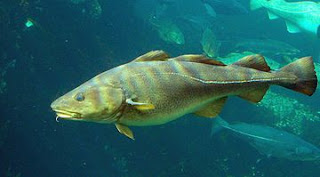Cod is the common name for the genus Gadus of demersal fishes, belonging to the family Gadidae. Cod is
 | |
| |
Cod is popular as a food with a mild flavour and a dense, flaky white flesh. Cod livers are processed to make cod liver oil, an important source of vitamin A, vitamin D, vitamin E and omega-3 fatty acids (EPA and DHA). Young Atlantic cod or haddock prepared in strips for cooking is called scrod. In the United Kingdom, Atlantic cod is one of the most common ingredients in fish and chips, along with haddock and plaice. It is also frequently consumed in Portugal, Spain, Italy, France and Brazil. Cod flesh is moist and flaky when cooked and is white in color.
At various times in the past, taxonomists included many species in the genus Gadus. Most of these are now either classified in other genera, or have been recognized as simply forms of one of three species. All these species have a number of common names, most of them ending with the word "cod", whereas other species, as closely related, have other common names (such as pollock, haddock, etc.). On the other hand, many other, unrelated species also have common names ending with cod. The usage often changes with different localities and at different times.
Cod forms part of the common name of many other fish no longer classified in the genus Gadus. Many are members of the family Gadidae; others are members of three related families within the order Gadiformes whose names include the word "cod": the morid cods, Moridae (100 or so species); the eel cods, Muraenolepididae (four species); and the Eucla cod, Euclichthyidae (one species). The tadpole cod family (Ranicipitidae) has now been placed in Gadidae
Some fish commonly known as cod are unrelated to Gadus. Part of this name confusion is market-driven. Severely shrunken Atlantic cod stocks have led to the marketing of cod replacements using names of the form "x cod", according to culinary rather than phyletic similarity. The common names for the following species have become well established; note that all inhabit the Southern Hemisphere.
Perciformes
Fish of the order Perciformes that are commonly called "cod" include:
*Blue cod Parapercis colias
*Eastern freshwater cod Maccullochella ikei
*Mary River cod Maccullochella peelii mariensis
*Murray cod Maccullochella peelii peelii
*Potato cod Epinephelus tukula
*Sleepy cod Oxyeleotris lineolatus
*Trout cod Maccullochella macquariensis
*The cod icefish family, Nototheniidae, including:
*Antarctic cod Dissostichus mawsoni
*Black cod Notothenia microlepidota
*Maori cod Paranotothenia magellanica
*Rock cod, reef cod, and coral cod
Almost all coral cod, reef cod or rock cod are also in order Perciformes. Most are better known as groupers, and belong to the family Serranidae. Others belong to the Nototheniidiae. Two exceptions are the Australasian red rock cod, which belongs to a different order (see below), and the fish known simply as the rock cod and as soft cod in New Zealand, Lotella rhacina, which as noted above actually is related to the true cod (it is a morid cod).
*Scorpaeniformes
*From the order Scorpaeniformes:
*Ling cod Ophiodon elongatus
*Red rock cod Scorpaena papillosa
*Rock cod Sebastes
*Ophidiiformes
The tadpole cod family, Ranicipitidae, and the Eucla cod family, Euclichthyidae, were formerly classified in the order Ophidiiformes, but are now grouped with the Gadiformes.
Some fish that do not have "cod" in their names are sometimes sold as cod. Haddock and whiting belong in the same family, the Gadidae, as cod.
*Haddock Melanogrammus aeglefinus
*Whiting Merlangius merlangus
Cod is popular as a food with a mild flavor and a dense, flaky white flesh. Cod livers are processed to make cod liver oil, an important source of vitamin A, vitamin D, vitamin E and omega-3 fatty acids (EPA and DHA).
Young Atlantic cod or haddock prepared in strips for cooking is called scrod. In the United Kingdom, Atlantic cod is one of the most common ingredients in fish and chips, along with haddock and plaice. Cod's soft liver can be tinned (canned) and eaten. It is an important source of vitamin A, vitamin D, vitamin E and omega-3 fatty acids (EPA and DHA).[citation needed] Cod is mainly consumed in Portugal, Spain, Italy and Brazil. Cod flesh is moist and flaky when cooked and is white in color.
USDA data: Pacific cod; Atlantic cod.
 |
| Preserved codfish |
No comments:
Post a Comment